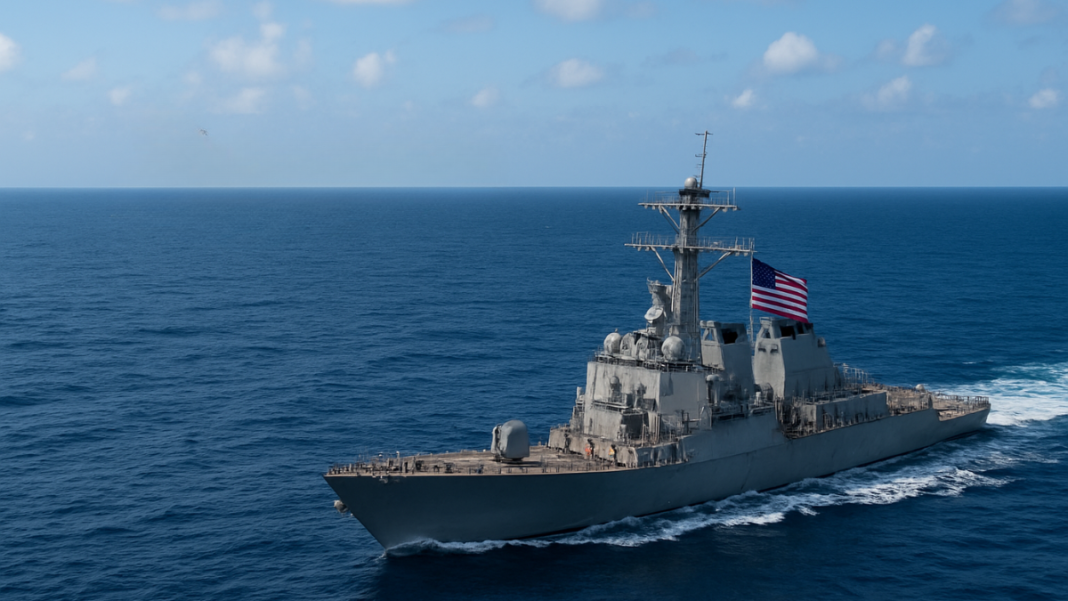Two armed Venezuelan fighter jets flew over a U.S. Navy destroyer in the Caribbean on Thursday, creating a tense moment at sea. The aircraft passed directly above the USS Jason Dunham, an Aegis guided-missile destroyer equipped with advanced defense systems capable of tracking and intercepting aerial threats. The sudden maneuver immediately drew attention due to the risks involved whenever combat aircraft approach a heavily armed warship.
Venezuelan Fighter Jets Conduct Provocative Flyover
Defense Department officials described the flyover as a calculated “show of force.” They said the action was not accidental but a deliberate attempt to send a political and military signal. Military forces often encounter each other in international waters, but armed jets flying directly over a U.S. destroyer raised concerns because observers saw it as an effort to test boundaries and measure the U.S. response.
The Navy destroyer operated legally in international waters at the time of the incident. Officials said the vessel conducts ongoing missions in the region to disrupt drug trafficking and counter criminal organizations. The sudden appearance of the Venezuelan fighter jets increased tensions around these operations, where overlapping patrols by both militaries raise the chance of close encounters.
Venezuela blasts U.S. flotilla as “cannon diplomacy” with warships at its doorstep
Later in the day, officials issued a statement and confirmed that the jets had approached the Navy vessel. The message condemned the maneuver as “highly provocative” and claimed the act aimed to interfere with U.S. counter-narcotics and counter-terrorism missions in the Caribbean. The statement also warned against further attempts to obstruct naval operations, framing the flyover as part of a broader challenge to American efforts in the region.
U.S. Navy Warships Confront Venezuelan Fighter Jets
The USS Jason Dunham is part of a flotilla of U.S. Navy vessels deployed to the waters surrounding Venezuela. These ships are tasked with stopping drug trafficking routes used by organized criminal networks. Officials describe the mission as part of broader operations against narco-terrorism.
The deployment of Navy destroyers, support ships, and surveillance assets reflects a significant effort to disrupt maritime smuggling routes. According to defense sources, criminal groups have used Caribbean waters to transport narcotics from South America toward international markets. By stationing warships nearby, the U.S. military aims to intercept these shipments before they spread further.
Venezuelan crude oil makes a stealth return — Chevron tankers dock in U.S. ports despite sanctions
The presence of American warships so close to Venezuelan territory has fueled anger in Caracas. In response, Venezuela has increased its own military patrols. Drones, coastal defenses, and naval ships have been mobilized to track movements in nearby waters. Sending Venezuelan fighter jets into the skies above the USS Jason Dunham was seen as a direct attempt to demonstrate strength in the face of U.S. operations.
This incident underscores how both sides are now actively showing military power in the same region. While U.S. officials insist their mission is focused only on criminal organizations, Venezuela views the activity as a threat to its sovereignty. The presence of heavily armed Venezuelan fighter jets in the area highlights the seriousness of the standoff.
Rising Maritime Tensions and Deadly Confrontations
The dramatic flyover came just days after another confrontation at sea. U.S. military officials reported striking a vessel they alleged was carrying narcotics from Venezuela. Reports said U.S. forces killed 11 people on board and linked them to the criminal organization Tren de Aragua, which officials accuse of violent and illegal activities across the region.
Venezuelan officials denied any link between their government and criminal cartels. They strongly rejected accusations of supporting drug trafficking and instead condemned the U.S. naval buildup as a “criminal threat.” Meanwhile, defense officials warned that Venezuelan fighter jets or naval assets that interfere with counter-narcotics missions would face heightened caution.
China warns US over Venezuela standoff: ‘Sovereignty must not be trampled’
This clash at sea adds to a growing list of incidents that mark rising tensions in the Caribbean. Each step — whether it is the deployment of warships, the patrol of drones, or the launch of Venezuelan fighter jets — contributes to an environment of confrontation.
The flyover of armed jets above a U.S. destroyer stands as one of the most visible and symbolic acts in this ongoing standoff. With naval groups stationed offshore, aerial patrols overhead, and constant monitoring on both sides, the waters near Venezuela have become one of the most tense and militarized zones in the Western Hemisphere in recent years.

